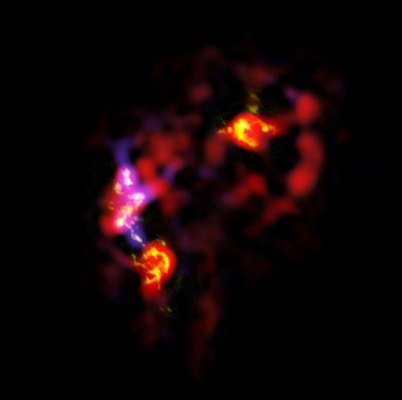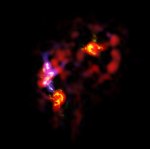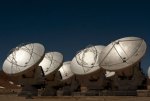The biggest, bestest, and most complicated telescope in all the land just took its first few shots of the cosmos, getting a detailed look at galaxies and gasses that have never been clearly seen before. The ALMA telescope in Chile, otherwise known as the Atacama Large Millimeter/submillimeter Array, is a joint-venture project backed by Canada, Chile, the EU, Japan, Taiwan and the good ol’ US of A.
The ALMA telescope is not quite like the visible-light and infrared telescopes predominantly used today. It uses a whole group of radio telescopes that are linked together, giving it the ability to see much longer wavelengths and thus, deliver unique photos of the universe. The purpose, quoth ALMA, is to “understand how galaxy collisions can trigger the birth of new stars.” This may give us a better understanding of what the universe looked like in its infancy.
According to the AFP, the ALMA telescope is between 10 and 100 times more powerful than other similar instrumentation used elsewhere. That’s a wide range, so presumably the ALMA telescope is 10 times more powerful than the next-best telescope in its class, and 100 times more powerful than the worst. The very first images taken with ALMA were of the Antennae Galaxies, which reside about 70 million light years away in the Corvus constellation.
One of the scheduled projects that will incorporate the ALMA telescope includes work by David Wilner of the Harvard-Smithsonian Center for Astrophysics, who plans to hunt for the building blocks of solar systems. “We will use ALMA to image the ‘birth ring’ of planetesimals that we believe orbits this young star,” said Wilner of a star 33 light years away called AU Microscopii, which is just one percent the age of the sun. “We hope to discover clumps in these dusty asteroid belts, which can be the markers of unseen planets.”
The location of the ALMA telescope is especially advantageous. In the Atacama desert in Chile, ALMA sits 16,400 ft. above sea-level, in an incredibly dry environment. These are ideal conditions for astronomy, although human survival could prove a bit tough. The European Extremely Large Telescope (love that name), which is set to begin operating in 2018, will also be in the Atacama desert.




